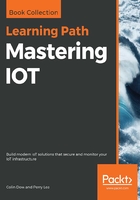
IoT Architecture and Core IoT Modules
The IoT ecosphere starts with the simplest of sensors located in the remotest corners of the earth, and translates analog physical effects into digital signals (the language of the internet). Data then takes a complex journey through wired and wireless signals, various protocols, natural interference, and electromagnetic collisions, before arriving in the ether of the internet. From there, packetized data will traverse various channels arriving at a cloud or large data center. The strength of IoT is not just one signal from one sensor, but the aggregate of hundreds, thousands, potentially millions of sensors, events, and devices.
This chapter starts with a definition of IoT versus machine-to-machine architectures. It also addresses the architect's role in building a scalable, secure, and enterprise IoT architecture. To do that, an architect must be able to speak to the value the design brings to a customer. The architect must also play multiple engineering and product roles in balancing different design choices.
This book will cover everything from the transformation of physical to digital sensing, power systems and energy storage, to manage billions of devices to near meter, near kilometer, and extreme range communication systems and protocols, to network and information theory, to internet protocols for the IoT, to the role of edge routing and gateways. The book then turns to the application of data through cloud and fog computing, as well as advanced machine learning and complex event processing. The final content investigates security and the vulnerability of the largest attack surface on earth.